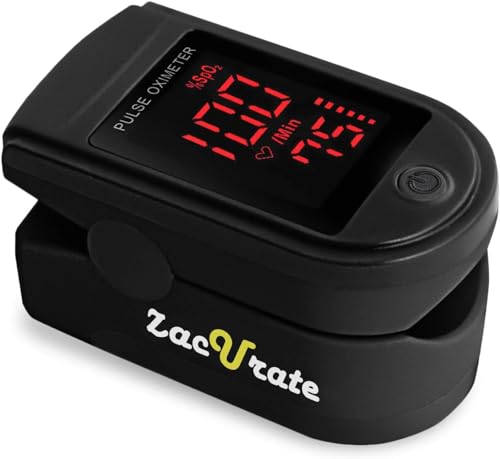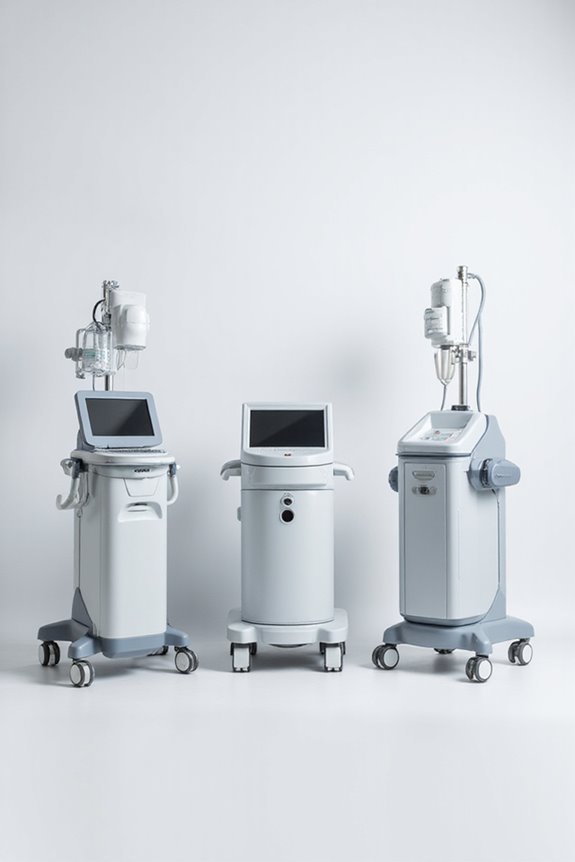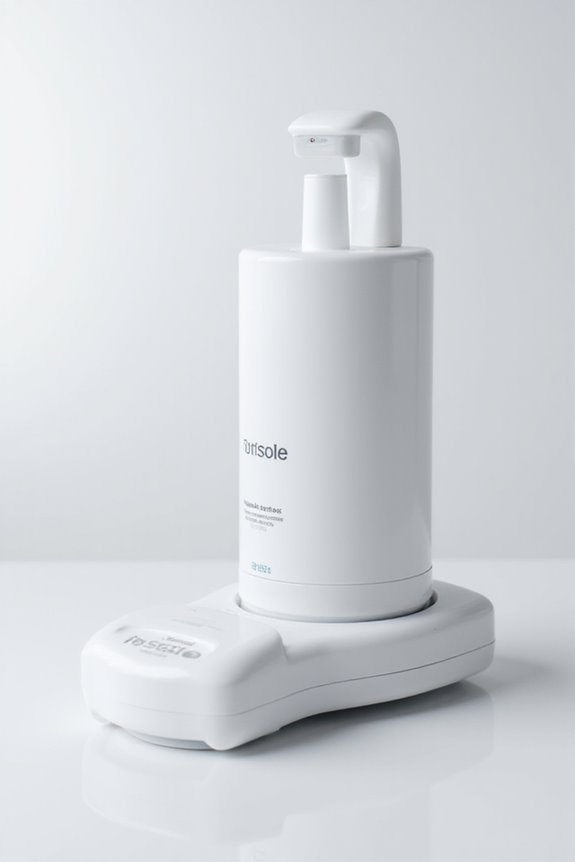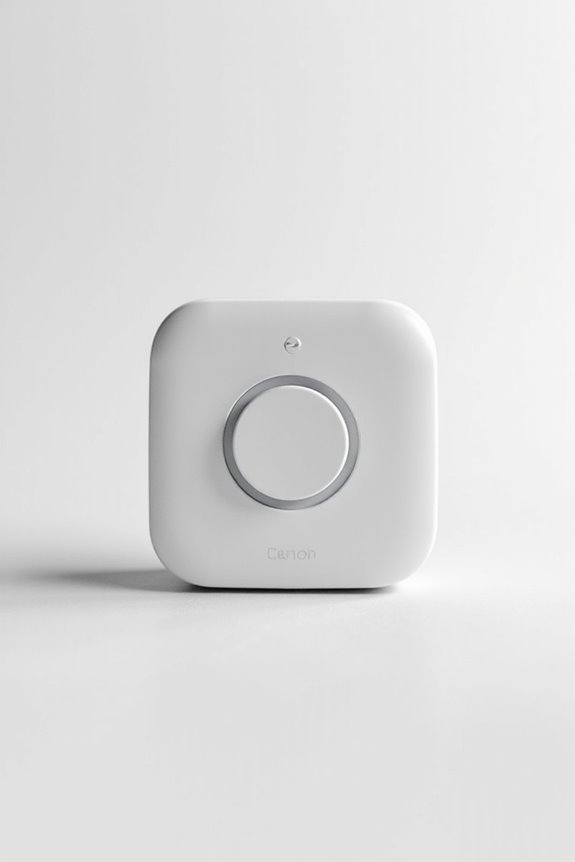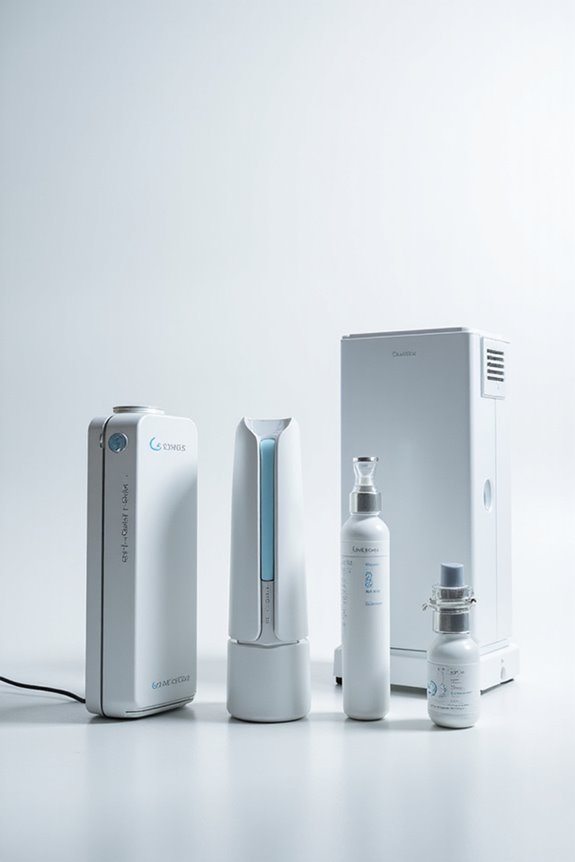As an Amazon Associate, we earn from qualifying purchases. Some links may be affiliate links at no extra cost to you. Although our opinions are based on curated research, we haven't used these products. Articles generated with AI.
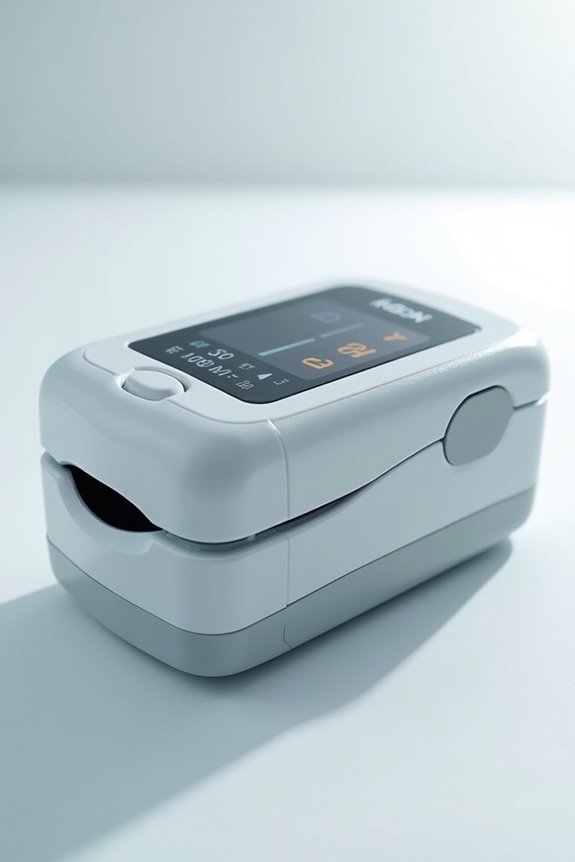
The 5 Best Fingertip Pulse Oximeters of 2025 – Reliable Health Monitoring at Your Fingertips
In 2025, the top five fingertip pulse oximeters for reliable health monitoring include:
- Zacurate Pro Series 500DL, known for its large LED screen and quick 10-second readings.
- A 4 Color OLED Display model with memory tracking over 20 days.
- A simple one-button Fingertip Pulse Oximeter with fast results.
- A portable LED Display version designed for all ages.
- The Innovo Deluxe iP900AP with enhanced accuracy features.
Discover essential factors for selecting the right device.
Key Takeaways
- Look for pulse oximeters with a quick reading time of 8 to 10 seconds for efficient health monitoring.
- Choose models with large, high-quality displays for visibility, especially for elderly users or those with visual impairments.
- Ensure reliability and accuracy by selecting devices supported by clinical studies, minimizing risks of misdiagnosis.
- Opt for user-friendly designs featuring simple one-button controls and auto shut-off for convenience and battery conservation.
- Consider pulse oximeters that accommodate various finger sizes while being lightweight and portable for easy transport.
Zacurate Pro Series 500DL Fingertip Pulse Oximeter Blood Oxygen Saturation Monitor
Zacurate Pro Series 500DL Fingertip Pulse Oximeter Blood Oxygen Saturation Monitor with Silicone...
- ACCURATE AND RELIABLE - Accurately determines your SpO2 (blood oxygen saturation levels), pulse rate and pulse strength in 10 seconds and displays it conveniently on a...
- FULL SPO2 VALUE - The ONLY LED pulse oximeter that can read and display SpO2 up to 100%.
- SPORTS/HEALTH ENTHUSIASTS - For sports enthusiasts like mountain climbers, skiers, bikers, and anyone needing to monitor their SpO2 and pulse rate. The pulse oximeter LED...
The Zacurate Pro Series 500DL Fingertip Pulse Oximeter is an excellent choice for sports enthusiasts and aviation professionals who need a reliable method for monitoring blood oxygen saturation levels and pulse rates.
- Key Features:
- Measures SpO2, pulse rate, and pulse strength in 10 seconds.
- Large digital LED screen for easy reading.
- Suitable for ages 12 and above with a range of finger sizes.
- Accessories:
- Includes 2 AAA batteries, silicone cover, and lanyard.
- Compact design for portability; 12-month warranty provided.
Best For: Sports enthusiasts, aviation professionals, and anyone monitoring blood oxygen levels and pulse rates on the go.
Pros:
- Accurate measurements of SpO2, pulse rate, and pulse strength in just 10 seconds.
- Large, user-friendly digital LED screen for easy readability.
- Compact and portable design with essential accessories included, making it convenient for travel.
Cons:
- Some users find the silicone cover difficult to use and not aesthetically pleasing.
- May require users to ensure optimal conditions for accurate readings (e.g., warm hands, no nail polish).
- Limited age range applicability, as it is designed for ages 12 and above.
Pulse Oximeter with 4 Color OLED Display
Sale
Alecaremed Pulse Oximeter, 4 Color OLED Display Oxygen Monitor Fingertip with 20 × Memory, Blood...
- 20 × MEMORY FUNCTION - Pulse oximeter with memory measurement 30s countdown automatic memory results. Finger oxygen monitor displays the latest 5 measurement results on...
- FASTER & MORE ACCURATE - Pulse oximeter fingertip utilizes advanced intelligent chips to ensure faster detection speed, and its dual light-blocking shield structure...
- LARGER & BRIGHTER SCREEN - The oxygen saturation monitor features a 1.3" TFT-OLED display with a protective cover that is larger than other 0.9" screens, ensuring clear...
Pulse oximeters equipped with a 4 Color OLED display are ideal for both adults and children aged six and older, thanks to their clear visibility and user-friendly interface.
- Features:
- 20 × memory function for tracking oxygen levels over 20 days
- Advanced intelligent chips guarantee faster detection
- Dual light-blocking shield structure for accurate results
- 1.3 TFT-OLED display with 5 adjustable brightness levels
- User Experience:
- Comfortable silicone design guarantees snug fit
- Provides real-time readings of SpO2, pulse rate, and battery level
- Customer Feedback:
- Generally positive reviews; praised for accuracy and comfort
- Durable construction and ease of use noted by users
Best For: Individuals aged six and older who need to monitor their oxygen levels regularly, including those with health conditions like POTS and sleep apnea.
Pros:
- 20 × memory function allows tracking of oxygen levels over 20 days.
- Comfortable silicone design ensures a snug fit for optimal accuracy.
- Clear 1.3 TFT-OLED display with adjustable brightness levels for easy visibility.
Cons:
- Alarm feature for low oxygen levels may be considered irritating by some users.
- Lack of an app for tracking and sharing data with healthcare providers.
- Some users may desire a more advanced user interface for settings navigation.
Fingertip Pulse Oximeter Blood Oxygen Monitor
Sale
Fingertip Pulse Oximeter Blood Oxygen Monitor Pulse Ox, Heart Rate and Fast Spo2 Reading Oxygen...
- Easy to use: this finger pulse oximeter designed with one button control which makes measurement more convenient and easier, users just need to put one of his fingers...
- Auto shutdown: the oxygen level monitor automatically powers off after 10 seconds of inactivity
- Accurate and fast: our oxygen blood monitor can accurately determine your spo2 blood oxygen saturation levels in 10 seconds and oled display make this finger oxygen...
For individuals monitoring their health, especially those with respiratory conditions like COPD, a Fingertip Pulse Oximeter Blood Oxygen Monitor offers essential functionality.
Product Overview and Features:
- Measures blood oxygen saturation (SpO2) and pulse rate.
- Simple one-button control with results on an OLED screen.
- Auto shutdown after 10 seconds of inactivity.
Performance and User Experience:
- Fast and accurate readings within 10 seconds.
- Bright display easily readable in low light conditions.
- Compact design fits conveniently in first aid kits or bags.
Power Supply:
– Operated by 2 AAA batteries, offering good battery life and easy replacement.
Best For: Individuals monitoring their health, particularly those with respiratory conditions such as COPD or anxiety management.
Pros:
- Easy one-button control and fast readings within 10 seconds.
- Compact and portable design, ideal for travel, first aid kits, or gym bags.
- Bright and clear OLED display ensures readability even in low light.
Cons:
- Some users report accuracy issues with inconsistent readings if the device is not correctly positioned.
- Concerns about battery life affecting performance for some users.
- Mixed reviews suggest that individuals may need to consider other brands if accuracy is a priority.
Fingertip Pulse Oximeter with LED Display
Sale
Fingertip Pulse Oximeter, Blood Oxygen Saturation Monitor (SpO2) with Pulse Rate Measurements and...
- ACCURATE, RELIABLE, & QUICK READINGS - Clinically tested and proven consistent results. Receive blood SpO2, Pulse Rate, and Pulse Strength results within 8 to 10 seconds...
- SpO2, PULSE RATE, and PULSE BAR GRAPH READINGS - Simple bar graph that displays your Pulse Oximeter SpO2, Pulse Rate, and Pulse Strength results.
- SUITABLE FOR ALL AGES - Smart design allows for a range of finger sizes to fit into the Pulse Oximeter finger chamber, designed with latex free silicone material.
Ideal for athletes and individuals requiring regular monitoring of their oxygen levels, the Fingertip Pulse Oximeter with LED Display offers quick, reliable assessments in a compact design.
Key Features:
- Measures blood oxygen saturation (SpO2) and pulse rate.
- Provides results in 8 to 10 seconds on a large red LED display.
- Includes SpO2, pulse rate, and a pulse strength bar graph.
- Designed for all ages, with a latex-free silicone chamber for various finger sizes.
- Lightweight and portable, perfect for outdoor activities.
Included Accessories:
- Package comes with 2 AAA batteries, a protective case, and a user manual.
- Backed by a one-year manufacturer warranty.
Best For: Athletes and individuals needing regular monitoring of oxygen levels can benefit from the Fingertip Pulse Oximeter with LED Display.
Pros:
- Provides quick and accurate measurements of blood oxygen saturation (SpO2) and pulse rate.
- Features a large, easy-to-read red LED display for clear results.
- Lightweight and portable, making it ideal for home use or outdoor activities.
Cons:
- Mixed user feedback on accuracy and reliability, with some reporting inconsistent readings.
- Concerns regarding durability and quality control, with issues in newer models.
- Some users found it to be slow in response times compared to competing products.
Innovo Deluxe iP900AP Fingertip Pulse Oximeter Blood Oxygen Saturation Monitor
Innovo Deluxe iP900AP Fingertip Pulse Oximeter Blood Oxygen Saturation Monitor with Alarm,...
- Accurate and Reliable - The Innovo iP900AP Finger Pulse Oximeter is a premium model with an improved LED and sensor, allowing SpO2 and pulse rate measurement even at low...
- Plethymosgraph and Perfusion Index - Ensure accurate SpO2 and Pulse Rate readings. Eliminate doubts about reliability or reading issues.
- Upgraded Hardware and Software - Enhanced performance with internal upgrades. iP900AP model includes auditory alarm, pulse detection beeps, and adjustable display...
The Innovo Deluxe iP900AP Fingertip Pulse Oximeter excels as a reliable monitoring device for athletes and health-conscious individuals.
Key Features
- Measures SpO2 and pulse rate.
- Enhanced LED and sensor guarantee accuracy, even with low blood perfusion.
- Includes Plethysmograph and Perfusion Index (PI) for dependable readings.
Performance Insights
- Outperforms competitors in clinical studies.
- PI values below 0.2% may indicate cold fingers or improper placement.
User Convenience
- Operates with 2 AAA batteries and includes a lanyard.
- Simple, one-button operation caters to seniors and those less tech-savvy.
For precise health tracking, this device stands out.
Best For: The Innovo Deluxe iP900AP Fingertip Pulse Oximeter is best for athletes and health-conscious individuals who require accurate blood oxygen saturation monitoring.
Pros:
- Easy one-button operation suitable for seniors and users with limited technical skills.
- Quick readings, often within 10 seconds, even with slight movements.
- Reliable performance supported by clinical studies, incorporating advanced features like Plethysmograph and Perfusion Index.
Cons:
- Alarm volume may be too low for some users to hear.
- Some users report difficulty differentiating heart rate irregularities.
- Values below 0.2% on the Perfusion Index could indicate cold fingers or improper device positioning.
Factors to Consider When Choosing a Pulse Oximeter Fingertip
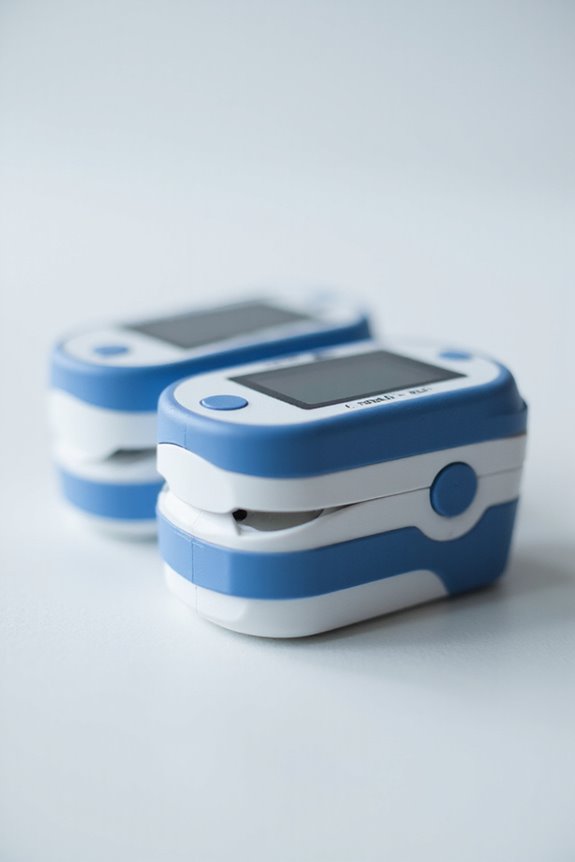
When choosing a fingertip pulse oximeter, you need to take into account several key factors that directly impact its performance. Measurement accuracy is essential, as it’s fundamental to obtaining reliable blood oxygen levels. Additionally, evaluate the display quality, battery life, user-friendliness, and portability to guarantee the device aligns with your needs.
Measurement Accuracy Importance
Measurement accuracy is critical in selecting a fingertip pulse oximeter, especially for individuals monitoring blood oxygen saturation (SpO2) levels. Accurate SpO2 measurements, typically ranging from 94-100%, are essential for identifying respiratory health issues.
Consider these factors:
- Inconsistent Readings: They can lead to misdiagnosis or delayed treatment.
- Measurement Time: Reliable devices provide stable results within 10 to 30 seconds.
- Usage Conditions: Poor blood flow, finger placement, or nail polish can affect accuracy.
- Advanced Features: Indicators like pulse strength and perfusion index enhance reliability, especially in low blood perfusion scenarios.
- Device Validation: Choose pulse oximeters validated in clinical studies for accuracy across various conditions.
Prioritizing measurement accuracy guarantees better health monitoring.
Display Quality and Size
Choosing a fingertip pulse oximeter with high display quality and appropriate size is essential for effective monitoring. Here are key factors to evaluate:
- Readability: Larger OLED screens enhance visibility, particularly for elderly users or those with visual impairments.
- Brightness Settings: Adjustable brightness improves visibility in varying lighting conditions, facilitating reading in both bright and dim environments.
- Multi-Directional Displays: These allow users to view measurements from different angles, enhancing usability.
- Additional Data: High-quality displays may show pulse strength and battery levels, delivering extensive information at a glance.
A bright, clear display, especially in low light, optimizes quick reading, enabling users to assess oxygen levels efficiently without straining their eyes. Prioritize display quality for reliable health monitoring.
Battery Life Considerations
Battery life is a significant factor when selecting a fingertip pulse oximeter, as it directly impacts the device’s usability and reliability.
- Most pulse oximeters operate on 2 AAA batteries, lasting several hours to days with continuous use.
- An auto-off feature is common, conserving battery life by shutting down the device after 8 to 10 seconds of inactivity.
- To extend battery life, always turn off the device when not in use and replace batteries before full depletion.
- Many models include a battery level indicator for monitoring status, ensuring timely replacements.
- Regular testing after battery changes is essential; low battery levels can affect performance and accuracy, compromising reliable readings.
Evaluate your options according to these battery life considerations for ideal functionality.
User-Friendly Operation
How can you guarantee that a fingertip pulse oximeter meets your operational needs?
- User Controls: Look for models featuring simple one-button controls, assuring ease of use for all ages.
- Display Quality: A clear, bright display is essential. Choose oximeters with adjustable brightness and orientation to adapt to different lighting conditions.
- Speed and Efficiency: Select devices providing quick readings, ideally within 8 to 10 seconds, to enhance monitoring efficiency.
- Comfort: Assure a snug yet gentle fit to promote accuracy and regular use.
- Instructional Support: Opt for models with straightforward user manuals and quick start guides, facilitating ease in both setup and operation.
Portability and Weight
When evaluating a fingertip pulse oximeter, portability and weight are critical considerations that can greatly influence your experience.
- Weight and Size: A lightweight and compact model fits easily in pockets or bags, enhancing on-the-go convenience.
- Transport Features: Detachable lanyards and carrying cases minimize damage risk during transport.
- Battery Life: Models with included batteries or energy-saving features, such as auto shut-off, increase convenience for frequent use.
- Design Considerations: Confirm the design accommodates various finger sizes while remaining lightweight to provide accurate readings without discomfort.
- Ease of Operation: Opt for models with simple one-button controls for quick access, particularly valuable when you’re in motion.
Considering these factors will help you select a convenient, efficient pulse oximeter.
Finger Size Compatibility
Selecting a fingertip pulse oximeter requires careful consideration of finger size compatibility, which plays a significant role in achieving reliable readings.
- Chamber Fit: A snug fit in the finger chamber is essential; loose fitting can result in inaccurate SpO2 and pulse rate measurements.
- Materials: Many models use latex-free silicone, providing enhanced comfort and accommodating various finger sizes.
- Versatility: Look for devices that cater to both adult and pediatric users, ensuring adaptability across different demographics.
- Adjustable Features: Check if the oximeter design includes adjustable or flexible chambers to fit larger or smaller fingers effectively.
Understanding these factors will help you choose a pulse oximeter that delivers precise results based on your specific needs.
Additional Features Availability
In evaluating fingertip pulse oximeters, additional features can greatly enhance both usability and monitoring effectiveness.
- Memory Functions: Look for oximeters that store previous readings, which aids in tracking blood oxygen levels over time.
- Adjustable Display: Consider devices with adjustable brightness and orientation for improved visibility under varying lighting conditions, catering to users of all ages.
- Alarm Notifications: Features like alarm notifications for low oxygen levels can provide timely alerts, enabling prompt health interventions.
- Ergonomic Design: Confirm the oximeter has a comfortable, user-friendly design to promote accurate readings.
- Advanced Insights: Advanced metrics, such as Perfusion Index (PI) and Plethysmograph, offer deeper insights into pulse strength and blood flow quality.
Warranty and Support
Warranty and support are critical factors in guaranteeing a reliable and effective experience with your fingertip pulse oximeter.
- Warranty Period: A longer warranty often reflects the manufacturer’s confidence in the product’s durability and performance. Look for terms covering defects in materials and workmanship.
- Customer Support Options: Verify the device includes accessible support, such as phone or email, for resolving potential issues quickly.
- Documentation: Manufacturers may offer user manuals and quick start guides to enhance your understanding of the device.
- Geographic Validity: Confirm that the warranty applies in your country, as support may vary based on location.
Considering these elements can greatly improve your overall satisfaction with the pulse oximeter you choose.
Frequently Asked Questions
How Do I Properly Clean My Fingertip Pulse Oximeter?
Cleaning your fingertip pulse oximeter is essential for accurate readings—the difference between health insights and uncertainty. Start by gently wiping the device with a soft, lint-free cloth. Avoid harsh chemicals; instead, use a solution of isopropyl alcohol diluted to 70%. Confirm that the sensor area is free of debris. Regular maintenance not only prolongs the device’s lifespan but also guarantees you receive precise measurements consistently.
Can I Use a Pulse Oximeter on Children?
Yes, you can use a pulse oximeter on children. However, consider the following:
- Size considerations: Choose a pediatric model for accurate readings.
- Age restrictions: Some devices specify age ranges for use.
- Accuracy: Confirm the child’s fingers are clean and free from nail polish.
Monitor readings closely, as children may require additional guidance during measurement. Always consult a healthcare provider for any concerns regarding a child’s health status.
What Factors Affect Pulse Oximeter Accuracy?
Pulse oximeter accuracy hinges on several critical factors.
- Peripheral Perfusion: Reduced blood flow can skew readings.
- Skin Thickness: Thicker skin may impede light transmission.
- Nail Polish or Artificial Nails: These can obstruct sensor function.
- Movement: Any motion during measurement can lead to erroneous results.
- Temperature: Cold extremities reduce blood flow, affecting output.
Are There Any Risks Associated With Using a Pulse Oximeter?
Using a pulse oximeter poses some risks to contemplate:
- Inaccurate Readings: Factors like poor circulation, skin pigmentation, or nail polish may affect results.
- Device Dependency: Relying solely on these readings can lead to delayed medical treatment.
- Infection Risk: Shared devices without proper sanitization can transmit pathogens.
To minimize these risks, verify device calibration, maintain hygiene, and consult healthcare professionals for any concerning results. Always use as part of a thorough health assessment.
How Do I Interpret the Readings From My Pulse Oximeter?
Interpreting your pulse oximeter readings isn’t rocket science. You’ll typically see two numbers: SpO2 and pulse rate.
- SpO2: This indicates your blood oxygen saturation. Values between 95% and 100% are normal. Below 90% may require medical attention.
- Pulse Rate: A normal range is 60 to 100 beats per minute.
Ensure you’re calm and still for accurate readings. Any significant variations should prompt consultation with a healthcare professional.

